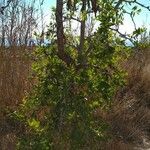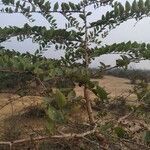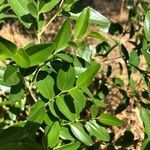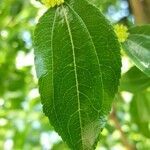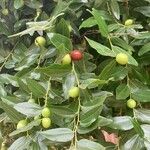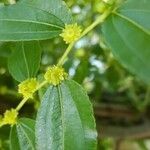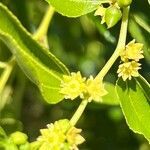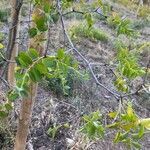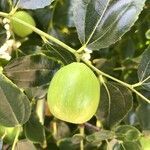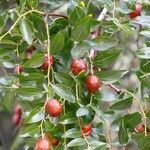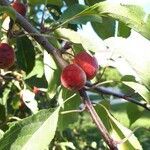| Therapeutic use
|
Antimutagenic agents (bark), Astringents (bark), Diarrhea (bark), Dysentery (bark), Furunculosis (bark), Gingivitis (bark), Ulcer (bark), Wounds and injuries (bark), Analgesics (fruit), Anthelmintics (fruit), Antiemetics (fruit), Antimutagenic agents (fruit), Antipruritics (fruit), Antitussive agents (fruit), Aphrodisiacs (fruit), Appetite stimulants (fruit), Asthenia (fruit), Astringents (fruit), Bronchitis (fruit), Cathartics (fruit), Colonic neoplasms (fruit), Diarrhea (fruit), Digestive system diseases (fruit), Emollients (fruit), Gout (fruit), Hematologic diseases (fruit), Hemorrhage (fruit), Hemostatics (fruit), Hepatomegaly (fruit), Histamine antagonists (fruit), Hypersensitivity (fruit), Hypnotics and sedatives (fruit), Inflammation (fruit), Leprosy (fruit), Liver diseases (fruit), Nausea (fruit), Pain (fruit), Parasympatholytics (fruit), Passive cutaneous anaphylaxis (fruit), Pectoralis muscles (fruit), General tonic for rejuvenation (fruit), Rheumatic diseases (fruit), Scurvy (fruit), Sinusitis (fruit), Skin diseases (fruit), Thirst (fruit), Ulcer (fruit), Vomiting (fruit), Wounds and injuries (fruit), Diaphoretic (fruit), Cooling effect on body (fruit), Abscess (leaf), Anesthetics, local (leaf), Anthelmintics (leaf), Antidotes (leaf), Antimutagenic agents (leaf), Anti-obesity agents (leaf), Antipyretics (leaf), Asthma (leaf), Astringents (leaf), Cachexia (leaf), Carbuncle (leaf), Diarrhea (leaf), Furunculosis (leaf), Gingival hemorrhage (leaf), General tonic for rejuvenation (leaf), Sexually transmitted diseases (leaf), Stomatitis (leaf), Syphilis (leaf), Typhoid fever (leaf), Urination disorders (leaf), Wounds and injuries (leaf), Diaphoretic (leaf), Analgesics (root), Antirheumatic agents (root), Cathartics (root), Fever (root), Gout (root), Headache (root), Ulcer (root), Wounds and injuries (root), Abdominal pain (seed), Antidotes (seed), Antiemetics (seed), Asthenia (seed), Asthma (seed), Brain diseases (seed), Cough (seed), Diarrhea (seed), Eye diseases (seed), Graves ophthalmopathy (seed), Hypnotics and sedatives (seed), Leukorrhea (seed), Pain (seed), Parasympatholytics (seed), Skin diseases (seed), Sleep aids, pharmaceutical (seed), Sleep initiation and maintenance disorders (seed), Thirst (seed), Vomiting (seed), Wounds and injuries (seed), Abscess (stem), Antidotes (stem), Carbuncle (stem), Diarrhea (stem), Dysentery (stem), Furunculosis (stem), Urination disorders (stem), Ague (unspecified), Anodyne (unspecified), Antidote(Aconite) (unspecified), Apprehension (unspecified), Cancer(Uterus) (unspecified), Diaphoretic (unspecified), Eruption (unspecified), Eye (unspecified), Inflammation (unspecified), Insomnia (unspecified), Laxative (unspecified), Marasmus (unspecified), Nausea (unspecified), Nervine (unspecified), Poultice (unspecified), Sedative (unspecified), Typhoid (unspecified), Abdomen (unspecified), Vertigo (unspecified), Viscera (unspecified), Amnesia (unspecified), Depurative (unspecified), Fever (unspecified), Hair-Tonic (unspecified), Pregnancy (unspecified), Tonic (unspecified), Wound (unspecified), Antidote (unspecified), Antidote(Scorpion) (unspecified), Anxiety (unspecified), Bronchitis (unspecified), Cancer (unspecified), Cancer(Breast) (unspecified), Cough (unspecified), Debility (unspecified), Dysentery (unspecified), Dyspepsia (unspecified), Emollient (unspecified), Gravel (unspecified), Hand (unspecified), Night-Sweat (unspecified), Pectoral (unspecified), Refrigerant (unspecified), Scabies (unspecified), Sialogogue (unspecified), Splenitis (unspecified), Ache(Stomach) (unspecified), Stomachic (unspecified), Throat (unspecified), Tumor(Abdomen) (unspecified), Headache (unspecified), Cancer(Digestive) (unspecified), Cholera (unspecified), Demulcent (unspecified), Edema (unspecified), Expectorant (unspecified), Sore (unspecified), Astringent (unspecified), Colic (unspecified), Diarrhea (unspecified), Foot (unspecified), Rinderpest (unspecified), Tuberculosis (unspecified), Hypertension (unspecified), Hypnotic (unspecified), Tranquilizer (unspecified), Uterotonic (unspecified), Poison (unspecified), Antirheumatic agents (unspecified), Autoimmune diseases (unspecified), Expectorants (unspecified), Gout (unspecified), Laxatives (unspecified), Sexually transmitted diseases (unspecified)
|
